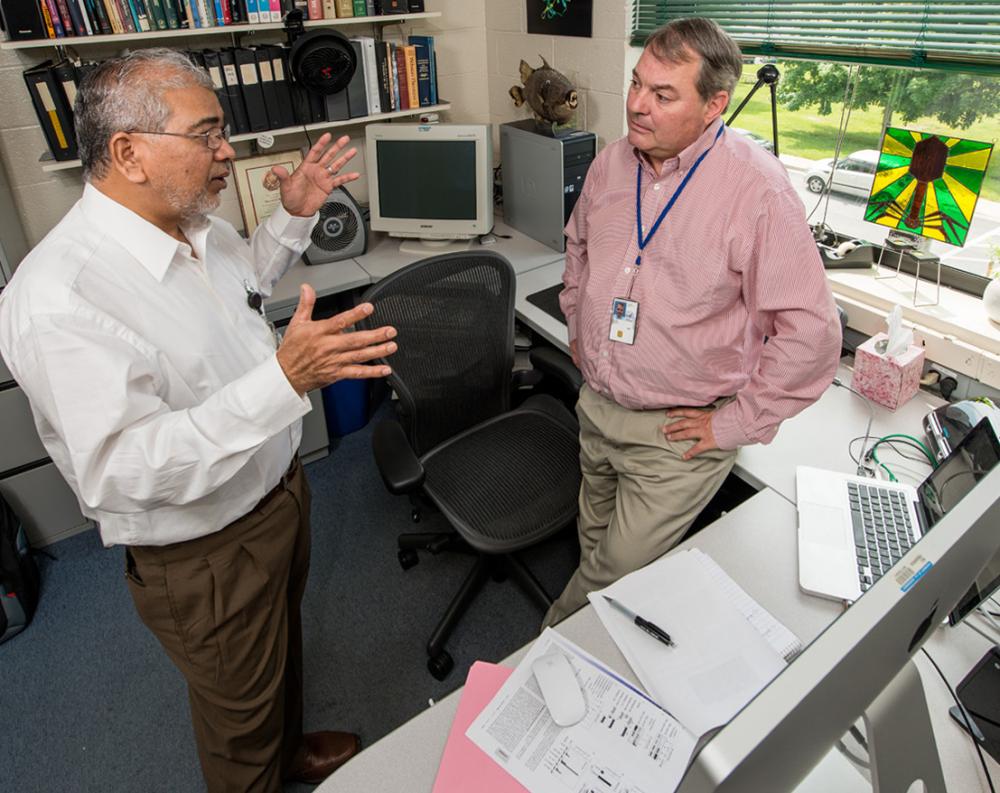By Nancy Parrish, Staff Writer
The winner of the 2012 competition for the best collaborative publication was announced on May 7, as part of the lead-up to the Spring Research Festival sponsored by the National Interagency Confederation for Biological Research (NICBR) and the National Cancer Institute at Frederick on May 8 and 9.
The winning paper was selected from five entries for best publication resulting from collaborative research between two or more NICBR partners based on the Fort Detrick campus. The partner agencies include the U.S. Army Medical Research and Materiel Command and U.S. Army Medical Research Institute of Infectious Diseases (USAMRIID); National Institute of Allergy and Infectious Diseases; National Cancer Institute; U.S. Department of Agriculture; National Biodefense Analysis and Countermeasures Center; Centers for Disease Control and Prevention; Naval Medical Research Center; and U.S. Food and Drug Administration.
The paper focuses on a potential therapeutic agent against Staphylococcal enterotoxin B (SEB), a deadly toxin produced by Staphylococcus aureus, which has been associated with severe—even fatal—food poisoning. Exposure to SEB, according to the paper, can trigger an exaggerated immune system response, often leading to toxic shock syndrome associated with organ failure and death.
Collaboration Began at 2010 Spring Research Festival
The study was the result of a collaboration that began at the 2010 Spring Research Festival, when David Waugh, Ph.D., senior investigator, Macromolecular Crystallography Laboratory, NCI at Frederick, opened discussions with Kamal Saikh, Ph.D. principal investigator, Integrated Toxicology Division, USAMRIID, about the research presented in Saikh’s poster. Waugh said that he realized “Saikh’s research could be enhanced and extended by employing biophysical methods such as NMR [nuclear magnetic resonance] and X-ray crystallography to study the interactions of small molecules with proteins that propagate signals in the innate immune response pathway.”
Those discussions led to research that focused on MyD88, a gene involved in the body’s immune response. The researchers produced a synthetic compound based on MyD88 that was introduced into mice either before or after SEB exposure. The effect was to reduce the level of immune response to the toxin and, in fact, protected the mice from getting toxic shock syndrome.
Waugh’s laboratory, which focuses on high-throughput protein expression and purification, and structural biology, produced the recombinant MyD88 protein for the studies, including samples enriched with the stable isotope 15N for the NMR experiments conducted by the laboratory of Julius Rebeck, Ph.D., at The Skaggs Institute for Chemical Biology, The Scripps Research Institute. Sun Ping, Ph.D., a visiting fellow in Waugh’s lab did the hands-on work for the project.
Saikh’s laboratory led the investigation.
Best Collaborative Publication among NICBR Partnering Laboratories, 2012Therapeutic Inhibition of Pro-inflammatory Signaling and Toxicity to Staphylococcal Enterotoxin B by a Synthetic Dimeric BB-Loop Mimetic of MyD88.Teri L. Kissner,1 Gordon Ruthel,1 Shahabuddin Alam,1 Enrique Mann,2 Dariush Ajami,2 Mitra Rebek,2 Eileen Larkin,1 Stefan Fernandez,1 Robert G. Ulrich,1 Sun Ping,3 David S. Waugh,3 Julius Rebek, Jr,3 and Kamal U. Saikh1,* 1Department of Immunology, United States Army Medical Research Institute of Infectious Diseases, Frederick, Maryland; 2Department of Chemistry, The Skaggs Institute for Chemical Biology, The Scripps Research Institute, La Jolla, California; 3Macromolecular Crystallography Laboratory, National Cancer Institute at Frederick, Frederick, Maryland PLoS ONE 7(7): e40773. doi:10.1371/journal.pone.0040773 To view the full article, go to: http://www.plosone.org/article/info%3Adoi%2F10.1371%2Fjournal.pone.0040773. |
Collaboration Was Key to Promising Results
Both researchers believe that the promising results of their study would not have been possible without the collaboration fostered by NICBR. “It enabled us to make an impact on the rapidly developing field of innate immunity, where complex signaling cascades are being uncovered,” Waugh said. This type of research “is not something we would normally do in my lab,” he added.
Saikh felt the collaboration enabled his research to progress toward developing therapeutic agents to treat SEB. “Currently, no licensed treatments are available for SEB intoxication,” he said. “Our work, combined with the work of Dr. Waugh’s group, enabled us to identify and validate a target-based potential lead candidate for the treatment of SEB.”
Waugh appreciates the chance to collaborate with other NICBR agencies. These collaborations, he said, present “an opportunity to participate in biomedical research that is not being conducted at my own institute, but which interests me nonetheless.” Further, he said that “in an environment in which resources for biomedical research in my own institute (NCI) have been reduced to an unprecedented low point, and with additional budget cuts all but certain, collaborations like this one are essential for us to be able to continue to conduct meaningful scientific research.”
Other interagency collaborations his laboratory is involved in include studies of Venezuelan equine encephalitis virus and human protein tyrosine phosphatases involved in cancer and host response to infectious agents. Both studies are collaborations with USAMRIID.


